In this post I have explained the making of a simple, cheap yet effective ultraviolet or UV-C home sanitizer circuit using ultra violet rays or UV-C. The idea was requested by Mr. Shah (kristin).
Using UV Rays against Coronavirus
The UV-C sanitizer circuit I have explained below can be effectively applied for sanitizing all external materials such as cellphones, vegetables, clothes, shoes, watches, or any material susceptible to a Coronavirus infection.
Ultraviolet UV-C rays can also be used to disinfect all food materials bought from the market to ensure these are well sterilized from all types of pathogens, bacteria, and even Coronavirus.
UV-C does not have any negative effect on food materials, so it can be safely used for disinfecting food items such as juices and apple cider, as well as grains, cheese, baked items, frozen foods, fresh fruits and vegetables, and liquid egg products, among other food and beverage items — are processed using UV-C,
Technical Specifications
Respected Sir,
I love your blog. I spend a lot time for searching circuit for countdown timer switch for 120v but I cannot find it. Can you please upload one or can guide me for the same?
I really need your help. Can you please able to give me circuit for countdown timer for 120V AC unit. I really tried in your blog to find one but I failed. Please Please give me circuit if you can.Thank you very much
I am making one UV sanitizer for disinfecting materials from Coronavirus. I want to have countdown timer in that which can countdown from couple of seconds to minutes. I want to connect it to 120 vac. Let say I want to place an iphone in that device for 3mins and 20 seconds for sanitization purpose after that time machines shuts off.
Shah
What is UV Rays
Ultraviolet (UV) light is generated in the form of electromagnetic radiation which have wavelength ranging from 10 nm to 400 nm (750 THz).
This wavelength is shorter than our normal visible light but longer than X-rays.
The sunlight also has UV content, which is only around 10% of the overall electromagnetic radiation generated by the Sun.
Other more effective sources of UV rays include the electric arcs and special lamps, for example mercury-vapor lamps, tanning lamps, and black lights.
Though ultraviolet with longer wavelengths is not really viewed as an ionizing radiation due to its photons not having sufficient energy to ionize atoms, this might still induce chemical reactions with numerous elements causing those elements to glow or fluoresce.
As a result, the chemical and biological outcomes of UV tend to be a lot more than other effects generated from heating elements, or effects from other UV radiation applications due to their reactions with organic substances.

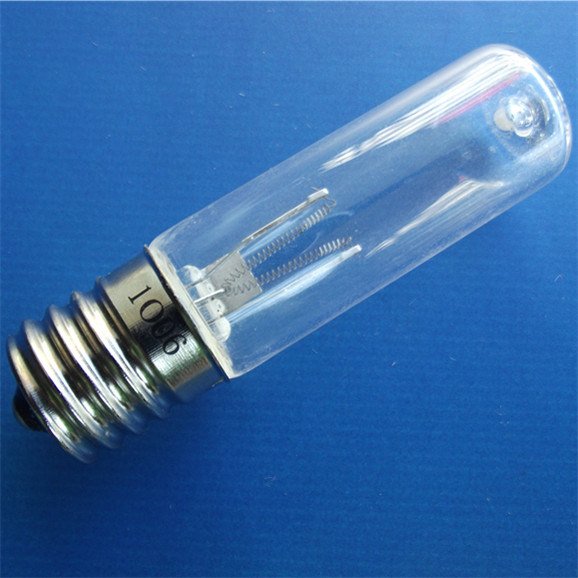
Types of UV Light
Due to their short wavelength Ultra-Violet (UV) light is invisible to human eyes. It can be sub-characterized into three fundamental types: UVA, UVB and UVC. UV-A wavelength ranges from 315 to 400 nm, UV-B wavelength ranges from 280 to 315 nm, and UV-C between 100 to 280 nm.
It is this third type UV-C which works most effectively as a disinfector, due to it ability to cause quick and maximum damage to any DNA or RNA material coming within its range of contact.

UVC radiation having wavelength between 100 nm and 280 nm has the ability to burst the DNA of bacteria, viruses and spores causing an immediate deactivation of their cells.
It can easily rupture the RNA protein of any virus, even the Novel Coronavirus, and therefore could be effectively applied for sanitizing purposes against novel Coronavirus pandemic.
UV radiation may be applied for several sterilization applications in water and air treatment, however mainly it works the best for disinfection process which eliminates all forms non-chemical based micro-organisms.
However, since human skin also contains DNA material, can be susceptible to UV radiation causing burns, skin damage and skin cancer.
Therefore, UV rays of any level must be strictly avoided from human skin contact. The disinfection process must be implemented only inside a well shielded container with the intended materials stuffed inside, which need to be disinfected.
Must read: UVC disinfecting lamps which can inactivate Coronavirus and yet be safe for humans.
Typical Bulb Specifications
There are many variants of bulbs, and LEDs available that are specifically created for generating the UV-C type of ultraviolet rays, and can be used for the making the proposed UV disinfector, for disinfecting a selected household material.

A popular, effective and cheap UV-C bulb is the 3 watt UV germicidal bulb, as shown below, having the following specifications
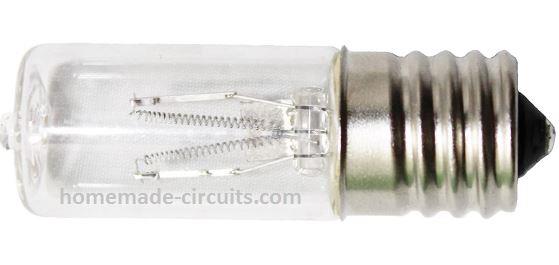
- Item Type: Ultraviolet UV-C Lamps
- Voltage: 85-265V
- is_customized: Yes
- Certification: CE, LVD, RoHS
- Temperature: Warm White (2700-3500K)
- Features: Germicidal
- Average Life (hrs): 1000
- Warranty: 1000 hours
- Base Type: E17
- Wattage: 3W
Circuit Description
A UV-C sanitizer is a device which cleans or sanitizes (by disinfecting) the surface in contact from all possible microbes, bacteria and germs that might be housing within the crevices of the material.
Since objects associated with us may travels with the owner across different places become prone to providing a cozy shelter for a virus like coronavirus.
Making of the proposed UV sanitizer is actually very easy, it's more about fabricating the enclosure than electronics.
The UV bulb which is in fact a disinfecting UV bulb can be easily procured readymade or through online stores, you will find a wide range of these bulbs, the one which is reasonably small with the following specs can be picked.
The image of the UV bulb can be seen in the above picture.
A simple DIY UV-C box is shown below, which could be built by anybody at home. The box can be a wooden box with aluminum foil glued on the inner surface. The UV bulbs may be installed as indicated in the picture. The quantity of bulbs is matter of choice, higher numbers may yield increased effectiveness against the viruses.
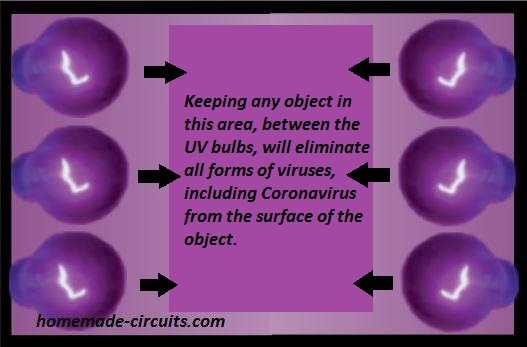
Among all other materials, our cellphone may be the most vulnerable to Coronavirus infection or harboring, therefore I will elucidate a method of using UV-C based enclosure that could be used for disinfecting a cellphone, or other similar objects from all possible microbes.
Making the UV Cell phone sanitizer cabinet
It can be done with appropriately cut and dimesioned acrylic sheets. Basically a rectangular transparent or colored acrylic box able to hold two UV bulbs vertically and the cell phone in the middle needs to fabricated and joined as shown in the following image.
Two UV bulbs can be seen fixed over a small wooden box. If a countdown timer is used in the design, it can be housed inside this wooden box ans wired with the bulbs as indicated in the following counter down timer circuit.
If a manual switch ON/OFF is desired ten the timer circuit can be eliminated and the two bulbs wired in parallel directly with the mains cord.
The acrylic box should have a few projected pillars at the the bottom and on the walls such that the cell phone can be inserted between these pillars and stands erect.
The above position would facilitate an optimal exposure to the two UV bulbs residing within a couple of mm from the cell phone
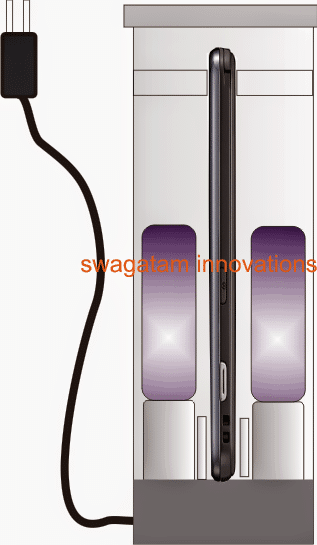
The Countdown Timer Circuit
The optional countdown timer can be associated with the above UV cell phone sanitizer assembly for automatically switching OFF the bulbs after a set predetermined time.
The entire circuit description and the parts list can be studied in this article.
The two UV simply needs to be wired in parallel with each other, and in series with the triac as shown in the below given diagram.
Circuit Diagram
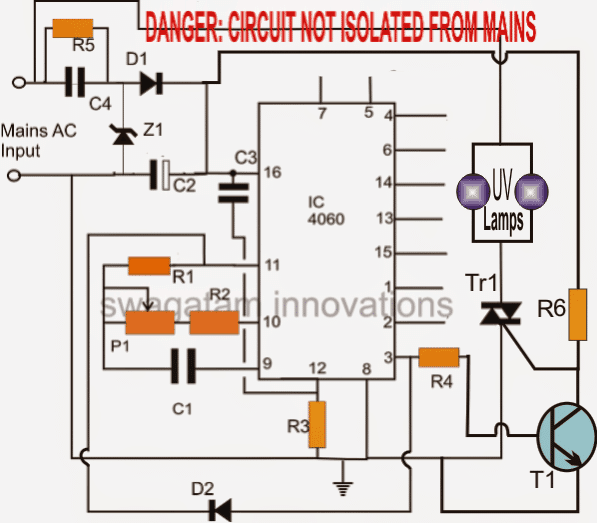
UV Disinfection Box with Timer
The next UV based disinfection concept is also similar to the above, except the IC which is an IC 555 here. Along with an automatic timer cut off, the design also features use of a reed relay which ensures that the UV bulbs are never switched ON when the door of the cabinet is in the open condition.
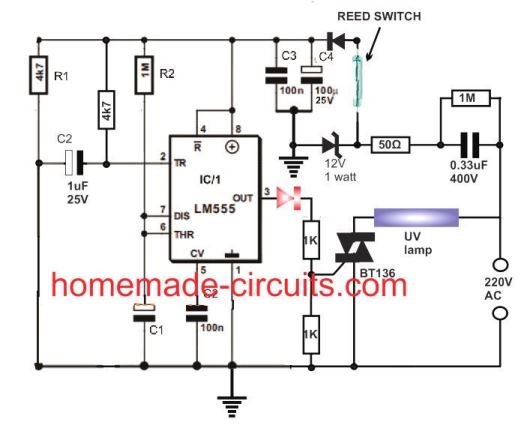
The circuit working can be understood with the help of the following points.
The IC 555 is wired as a standard monostable multivibrator, powered through a stabilized transformerless power supply circuit, comprising of C3, C4, 0.33uF, and the 12V zener diode.
As soon the circuit is powered from the AC mains, the 12V DC across the monostable instantly triggers the circuit via the 1uF capacitor connected pin2 of the IC. The capacitor momentarily grounds the pin2 of the IC activating its output pin3 with a positive supply.
The positive supply at pin3 activates the triac and the UV lamp.
The monostable now begins counting, and depending on the values of the C1, and R2, the pin3 and the triac remain switched ON for a stipulated period of time. When the time elapses, the pin3 becomes zero, switching off the triac and the UV lamp.
We can also see a reed relay connected in series with the positive line of the input supply.
This reed relay is coupled with a magnet, associated with door mechanism of the UV box cabinet. As long as the door is in the open position the magnet is pulled away from the reed relay, causing its contacts to remain open, and the monostable to be powered off. When the door is closed, the magnet is pulled close to the reed relay, forcing its contacts to close, and switch ON the supply for the monostable. The monostable now switches ON, causing the timer and the UV lamp to activate for the intended actions.
For DC Operation:
For DC operation using a 12V battery, the following type of the bulb could be employed:
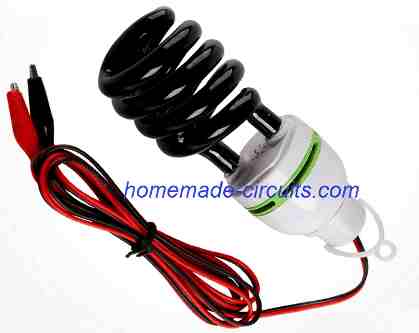
A timer is not shown here, the unit could be simply plugged in to any 12V automobile battery and switched ON for a specified amount of time inside an opaque container along with the device which needs to be sanitized. After this the unit could be unplugged.
If I put my CPAP machine, hose, and head gear in a box would this clean it?
Yes it will, however depending upon the surface area of the materials you may have to install more number of UV bulbs proportionately.
The circuit using 555 timer doesnt work any help would be highly appreciated
It will definitely work.Please Do this:
Remove the reed switch from the existing position and replace it with a link.
Now disconnect the connection between C2 and ground, and put the reed switch between the C2 and ground.
Remember the circuit is not isolated from mains AC, from be extremely careful while testing it.
Dear Sir Swagatam
Hello. Would you please tell me about the length of the time we need to
clean our cell phone?
Thanks a lot Sir
Best regards
Hello Najieh, I think 2 minutes is enough to ensure 100% killing of the pathogns.
Hello, I’m Korean. It’s very interesting. Is there a circuit motion video?
Hi, glad you liked it….sorry presently we do not have a video for this project!
how many minutes or seconds neede to disinfect grocery items
between 2 minutes to 5 minutes approximately…
Hi,
Can you help me using this UV bulbs to disinfect the room? Any circuit design separate to this?
Thanks in advance.
Hi, the procedure is the same as explained in the above article, but it must be used only for disinfecting objects, it can be very dangerous for human skin, so appropriate caution is recommended.
Hey Swagatam,
Going going on the website and providing people with great home-made solutions. As an engineer myself I realize how everyone should know some basic DIY electronics.
I noticed you describe these circuits but never mentioned any safe practices. The only mention was: ‘However, since human skin also contains DNA material, can be extremely susceptible to UV radiation causing burns, skin damage and skin cancer.
Therefore UV rays of any level must be strictly avoided from skin contact. The disinfection process must be implemented only inside a well shielded container with the required materials packed inside, which needs to be disinfected.’
People trying these as hobby may not be aware of the potential hazards associated with intense UV/ large currents/ capacitances etc. It must be made ABUNDANTLY CLEAR with VISIBLE WARNING signs. If something goes wrong with someone you could possibly face legal repercussions.
Great work though. I moved onto Photonics but am now taking up electronics again as a hobby hence discovered your website.
All the best!
Thank you Kaustubh, I completely agree with you. I have now highlighted the warning message in red color, so that it becomes clearly understandable to the readers. I wish you all the best, and congratulations on your return to the field of DIY electronics
Thank you for this article. This is very informative.
But I was under the impression that UV bulbs, like fluorescent tubes, require a ballast or they wouldn’t even light up.
How would you go about designing a circuit for a bulb like Philips 325126 9-watt PL-S TUV bulb? I think this tubes has a two pin G23 base with an internal capacitor.
Thanks again.
Glad you liked the post! However for implementing the above UV system the user is supposed to buy the entire tube/driver set, which is easily available from any reputed online shop.
If you want to make the driver then you can search online for 20 watt fluorescent ballast circuit, you may find many suitable designs
What replacement should I use instead of reed switch as in multisim reed switch is not available?
You can replace it with an On/OFF switch
Bt it is not working if I m using on off switch
And I have used bulb Instead of UV lamps
And the capacitor and all are the basic one na ? Like they are half portion is black n white so I have taken basic one which has only farad values it doesn’t have the voltage value is that fine?
Sorry, I can’t provide solutions to simulator results, but if you build it practically it will work without fail….
Hey Swagatam!
I had one more doubt regarding the same 555 timer circuit for UV Disinfection.
Is there any other alternative available for the reed switch mentioned in the circuit?
Awaiting your reply.
Hi Advait, If you do not want the circuit powering to be dependent on the door closing/opening of the cabinet, then you can replace the reed with a manual ON/OFf switch.
Or you can also use a press button ON/OFF switch, which will switch ON the unit when the door is closed, due to pressure.
Can you give the description and listen of the components used in the circuit
Components values are given in the diagram
I am planning to make a circuit with a timer and limit switch along with 4 nos UV tubes and their ballast.
Can you please share an electrical circuit so that I can try out my experiment. The limit switch is basically for the door when opened it should cut off the power so that by accident the lights should not turn on. Could you reply to my question in my email ID. Thanks for the help.
Please explain in more detail how the door should operate the UV lamps in conjunction with the timer, ….so that the function is understood correctly.
Dear Swagatam,
Kindly note the door is just like a microwave door. Infact the whole box is somewhat made like that. There will be 4nos uv tubes each being 16 watts each with their ballast. There will be a timer to set the time for it to light around msx 10 mins. There will also be a limit switch which would be for meat the door so as when it is running and if the door is opened the lights should go off.
Please send me a circuit to incorporate these parts. Thanks.
Thanks Rohinton, I’ll try to design it soon, and post it here for you!
Thanks a lot Swagatam, awaiting your reply.
Hello Rohinton, I have posted the design at the end of this article, please see the last diagram from this article:
https://www.homemade-circuits.com/homemade-uv-cell-phone-sanitizer/
hi
can we use ballast circuit of CFL tubes?, to burn the UV
You can try, it might work if the specifications match.
Can u discuss this circuit in further details.
Please reply on mail, then I will share the number
Hi..
Superb explanation and case story.
Can I make UVC sanitizer using SMD UV LEDs ??
If yes, is this effective as like using lamp / bulb ?
Thanks to reply.
Hi, thank you, and glad you liked the post, yes definitely you can use them but only if they are confirmed from an authorized lab regarding their efficacy against the novel coronavirus. If the product is without such guarantees, then it may not be so useful.
Thank you.
If I assume as per my reading on internet, every UVC of wavelength 100 to 280 nm would disinfect the things from bacteria and viruses including Covid 19.
Still will I have to confirm the efficiency of smd uv led of range 100 to 280 nm about coronavirus ?
I know this is out of box question to you from me. But I am interested to understand such things from brilliant mind like you.
If the LEDs genuinely emit UVC between 200 and 250 nm then it can be used for the specified purpose, but problem is how can we confirm this, the manufacturer could be giving us fake specifications regarding the product.
Hey Swagatam!
I’m fascinated by the explanation and concept of UV disinfection by you and wanted to try it on my own.
I’m having a doubt regarding a component in the circuit diagram uploaded by you.
It’s regarding the red coloured diode which is used in the out terminal of the 555 timer circuit, I’m unable to get to know what type it is and what are its specifications.
Please help me out.
Awaiting your reply.
Thank You Advait,
Glad you liked the post!
The red colored part is actually a red LED, for indicating the activation of the IC 555.
I hope this should have solved your doubts.
thank u sir
is it obligatory to use the timer ?
No.
The “effective and cheap UV-C bulb is the 3 watt UV germicidal bulb, as shown in your article” looks like the UV-C bulb i have from germguardian. it is supposedly a 10v bulb. it looks exactly like the bulb you show. does it require an oscillator circuit to operate from dc source to “fire it off”? part number of mine is LB1000. is this the same bulb. I noticed the spec. you gave shows 85-265 volts. Thanks
It does not require any oscillator, you can operate it directly from the mains AC outlet
I have one UV tube light. I got from old water purifier. So i have an idea for using this tube light to make mobile disinfection case. But i dont know what is supply voltage for this tubelight? And what time to be set for mobile disinfection?
But I want to make use of a circuit which could use less voltage and current (may be AC or DC current) instead of direct buying a bulb (" rel="ugc"> ). thnq in advance
). thnq in advance
OK in that case you could probably try using UV LEDs, in series and parallel connection. The main specifications of the LED as per one the Amazon products is given below:
Light Color : Violet
Voltage : DC 3V – 5V
Head Size (Approx) : 5mm
Note: Lens of the led bulb is clear but when led glow it turns in Violet color. Do not give more than 5 volts at the input otherwise bulb will fuse.
Package Include 100 x LED Light
Can we make this Cell phone sanitizer cabinet operable at less votlage by make use of any other circut or using low voltage UV lights
yes it is possible by using readymade 12V DC UV lamps, which has a built in inverter circuit, because the DC UV bulbs work with a high frequency oscillator. As ample unit is show below:
" rel="ugc">
Thnq so much swagatham . For project and for quick reply